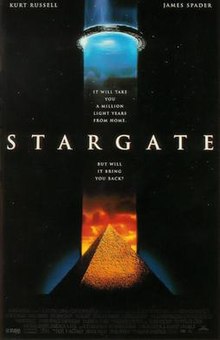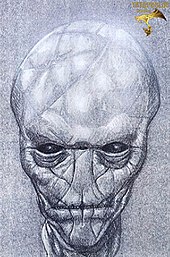Stargate SG-1 is a military science fiction adventure television series within Metro-Goldwyn-Mayer's Stargate franchise. The show, created by Brad Wright and Jonathan Glassner, is based on the 1994 science fiction film Stargate by Dean Devlin and Roland Emmerich. The television series was filmed in and around the city of Vancouver, British Columbia, Canada. The series premiered on Showtime on July 27, 1997, and moved to the Sci Fi Channel on June 7, 2002; the final episode first aired on Sky1 on March 13, 2007.

Jonathan J. "Jack" O'Neill is a fictional character in the MGM's military science fiction franchise Stargate, primarily as one of the main characters of the television series Stargate SG-1. Richard Dean Anderson played O'Neill in all the Stargate media since 1997, when he took over the role from actor Kurt Russell, who portrayed the character in the original Stargate film in 1994. O'Neill and Daniel Jackson are the only two characters to appear in both the original film and all three live-action Stargate television series.
Stargate Atlantis is an adventure and military science fiction television series and part of MGM's Stargate franchise. The show was created by Brad Wright and Robert C. Cooper as a spin-off series of Stargate SG-1, which was created by Wright and Jonathan Glassner and was itself based on the feature film Stargate (1994). All five seasons of Stargate Atlantis were broadcast by the Sci-Fi Channel in the United States and The Movie Network in Canada. The show premiered on July 16, 2004; its final episode aired on January 9, 2009. The series was filmed in and around Vancouver, British Columbia, Canada.

Stargate Infinity, often abbreviated as SGI or just Infinity, is a 2002–2003 animated science fiction television series co-produced by Les Studios Tex S.A.R.L. and DIC Entertainment Corporation, in association with MGM Television Entertainment as part of Metro-Goldwyn-Mayer's (MGM) Stargate franchise, but is not considered official Stargate canon. The show was created by Eric Lewald and Michael Maliani, as a spin-off series of Stargate SG-1, which was created by Brad Wright and Jonathan Glassner in 1997 after the release of the original film, Stargate (1994) by Dean Devlin and Roland Emmerich. The animation had a low viewership rating and poor reception; it was canceled after just one season.

Daniel Jackson, PhD, is a fictional character in the military science fiction franchise Stargate, and one of the main characters of the 1997 series Stargate SG-1. He is portrayed by James Spader in the 1994 film Stargate, and by Michael Shanks in Stargate SG-1 and other SG-1 derived media. Jackson is the only Stargate character to appear in all films and series in the franchise.

A Stargate is a fictional Einstein–Rosen bridge portal device within the Stargate fictional universe that allows practical, rapid travel between two distant locations. The devices first appeared in the 1994 Roland Emmerich film Stargate, and thereafter in the television series Stargate SG-1, Stargate Atlantis, and Stargate Universe. In these productions, the Stargate functions as a plot device, allowing the main characters to visit alien planets without the need for spaceships or any other type of technology. The device allows for near-instantaneous travel across both interstellar and extragalactic distances.
Stargate is a military science fiction media franchise based on the film directed by Roland Emmerich, which he co-wrote with producer Dean Devlin. The franchise is based on the idea of an alien wormhole device that enables nearly instantaneous travel across the cosmos. The franchise began with the film Stargate, released on October 28, 1994, by Metro-Goldwyn-Mayer and Carolco, which grossed US$197 million worldwide. In 1997, Brad Wright and Jonathan Glassner created a television series titled Stargate SG-1 as a sequel to the film. This show was joined by Stargate Atlantis in 2004, Stargate Universe in 2009, and a prequel web series, Stargate Origins, in 2018. Also consistent with the same story are a variety of books, video games and comic books, as well as the direct-to-DVD movies Stargate: Children of the Gods, Stargate: The Ark of Truth, and Stargate: Continuum, which concluded the first television show after 10 seasons.

"Wormhole X-Treme!" is the 100th episode of military science fiction adventure television show Stargate SG-1 and is the 12th episode of the fifth season. The episode was first broadcast September 8, 2001 on Showtime in the United States. It was written by series co-creator and executive producer Brad Wright along with supervising producers Joseph Mallozzi and Paul Mullie and was directed by Peter DeLuise.

"Children of the Gods" is the first episode of the military science fiction television series Stargate SG-1. It was written by producers Jonathan Glassner and Brad Wright and was directed by Mario Azzopardi. The episode first aired on July 27, 1997, on Showtime. Originally presented as a television movie, the episode would later be split into two parts for repeats and syndicated viewings. A new, updated cut, which is entitled "Children of the Gods – The Final Cut" was released on DVD on July 21, 2009 by MGM Home Entertainment.
"Within the Serpent's Grasp" is the first season finale of the science fiction television series Stargate SG-1. The episode continues on from the events of "There But for the Grace of God" and "Politics" and concludes in the season 2 opening episode "The Serpent's Lair". Written by James Crocker, showrunner Jonathan Glassner adapted the story into a teleplay, with David Warry-Smith directing. The episode first aired on March 6, 1998 on Showtime in the United States and on August 26, 1998 on Sky One in the United Kingdom.

The mythology of the Stargate franchise is a complex and eclectic fictional backstory, which is presented as being historical, of the Stargate premise. A "rich mythology and world-building" are used to establish "a vast cosmology and an interesting alternate take on the history of Earth"; a defining feature is "its use of ancient mythology, with stories that take inspiration from multiple places around the globe". Narratives center around xeno-mythology as experienced by humans during episodic contact with alien races. Audiences across a variety of platforms - including TV series, novels, comics and movies - witness the people of Earth exploring a fictional universe using the Stargate. Species established early on in the franchise recur throughout, with one adversary often dominating a particular story arc, which can continue across several seasons.
"Full Circle" is the season finale for season six of the Canadian-American military science fiction television series Stargate SG-1. It was originally intended to be the last episode of Stargate SG-1. The episode was written by executive producer Robert C. Cooper and directed by Martin Wood. The episodes received an average Nielsen household rating and a low syndication rating compared to other season six episodes. The episode got strong reviews from major media publishers worldwide.

Stargateliterature comprises the novels and short stories in the Stargate franchise fictional universe as well as a non-fiction devoted to the franchise. Stargate literary works follow no strict continuity with the series or each other and are often considered to be non-canon. There is a period of roughly a year between the original idea for a novel and the finalized product, causing problems for authors as they are unaware as to how the franchise will develop and change during the writing process. Despite this, the editors of Stargate literature function as the medium between the author and the production company.
Major General West, is a fictional character in the Stargate SG-1 universe, played by Leon Rippy. West headed the USAF's Project Giza, the forerunner of the SGC. He oversaw Dr. Catherine Langford's experiments with the Stargate until selecting, recalling, and delegating Colonel Jack O'Neil as military commander when Dr. Daniel Jackson joined the team. Upon the successful connection of the Earth Stargate to Abydos, West immediately militarized the program and locked out most of the civilian team previously under Dr. Langford. He then authorized the initial excursion to Abydos.

The first season of the military science fiction television series Stargate SG-1 commenced airing on the Showtime channel in the United States on July 27, 1997, concluded on the Sci Fi channel on March 6, 1998, and contained 22 episodes. The show itself is a spin-off from the 1994 hit movie Stargate written by Dean Devlin and Roland Emmerich. Stargate SG-1 re-introduced supporting characters from the film universe, such as Jonathan "Jack" O'Neill and Daniel Jackson and included new characters such as Teal'c, George Hammond and Samantha "Sam" Carter. The first season was about a military-science expedition team discovering how to use the ancient device, named the Stargate, to explore the galaxy. However, they encountered a powerful enemy in the film named the Goa'uld, who are bent on destroying Earth and all who oppose them.

Stargate is a 1995 platform game by Acclaim Entertainment for the Super Nintendo Entertainment System and Genesis/Mega Drive. It follows the adventures of Colonel Jack O'Neil as he struggles to free the slaves of Abydos, defeat Ra, and get his mission team back home using the stargate device. The game is based on the 1994 film of the same name.











